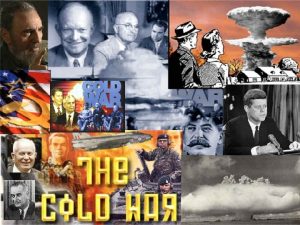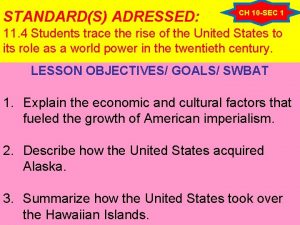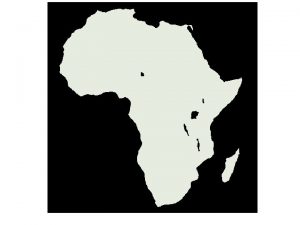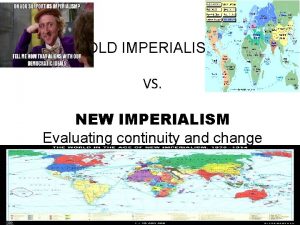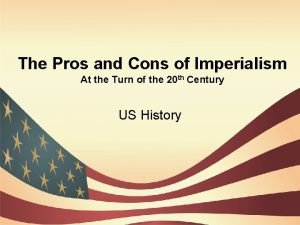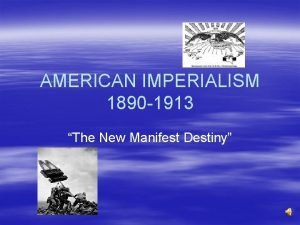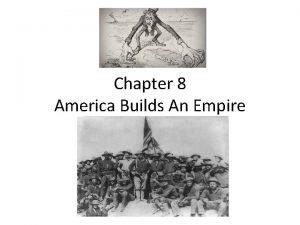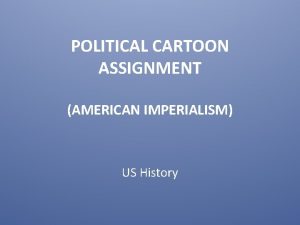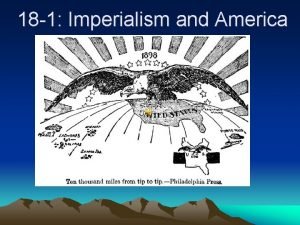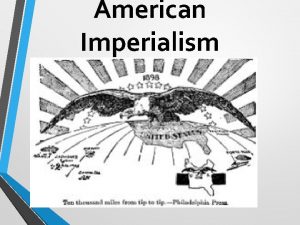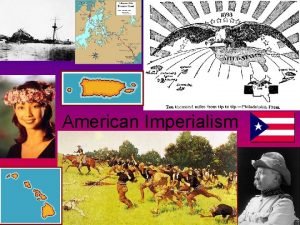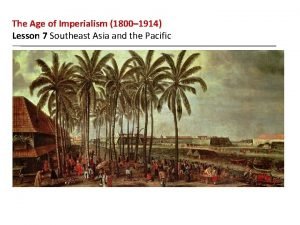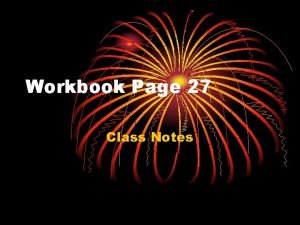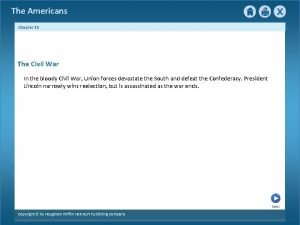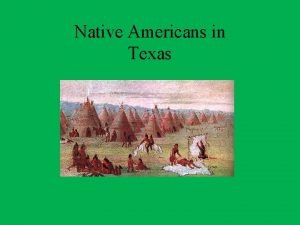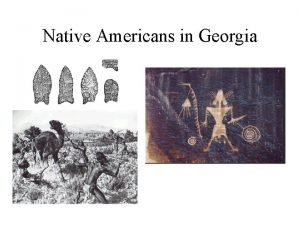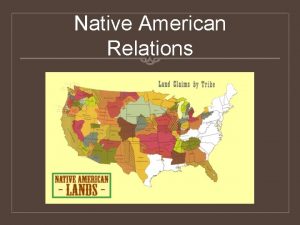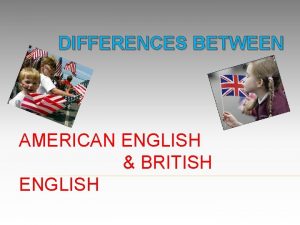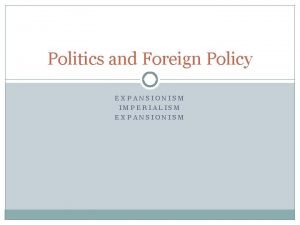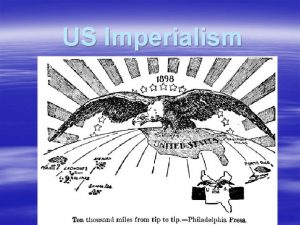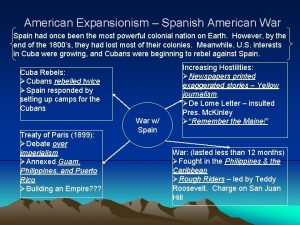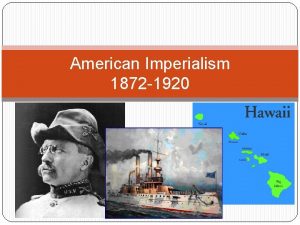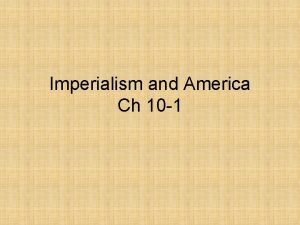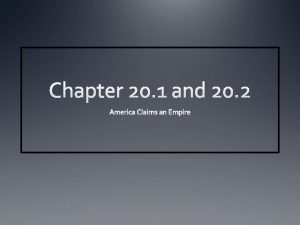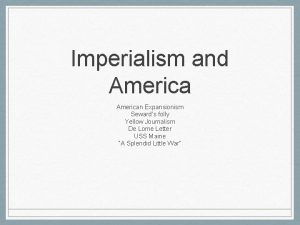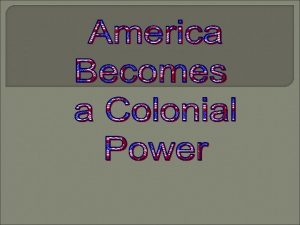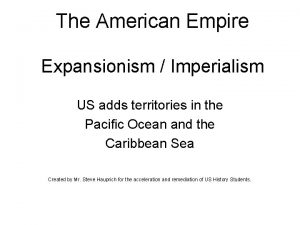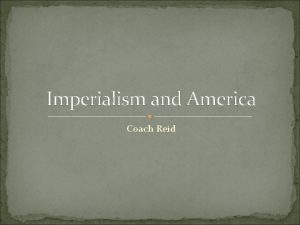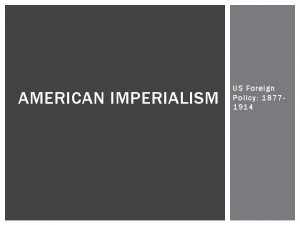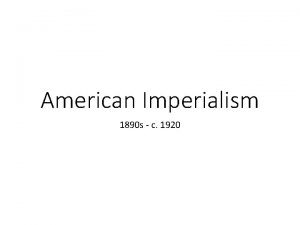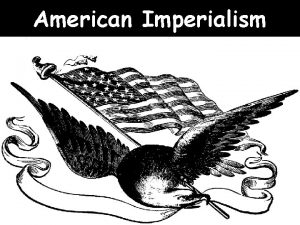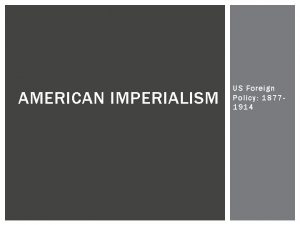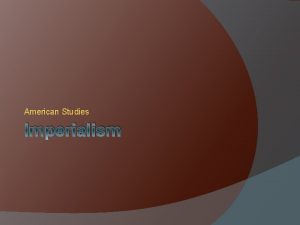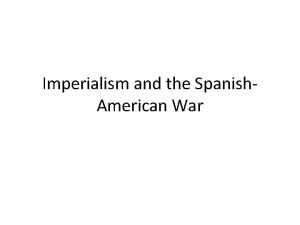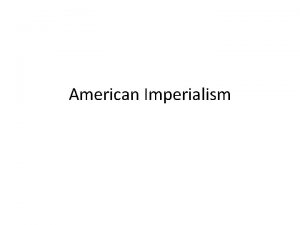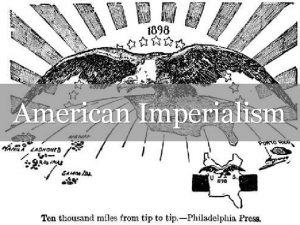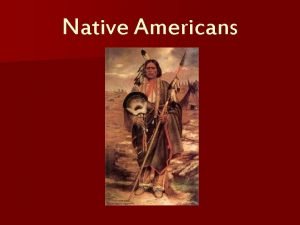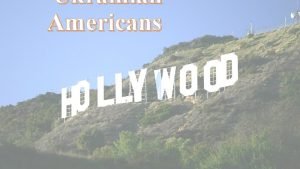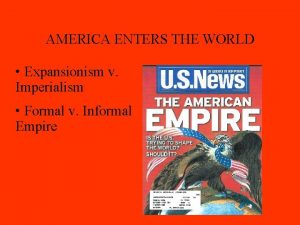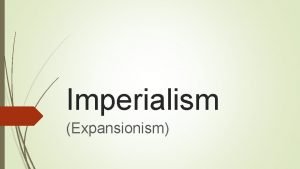Unit 2 American Imperialism American Expansionism Americans had

























- Slides: 25

Unit #2: American Imperialism

American Expansionism • Americans had always sought to expand the nation • Imperialism- policy in which stronger nations extend their economic, political, or military control over weaker territories • Many European nations had already established colonies around the world • Europeans target Africa- only Ethiopia and Liberia were independent nations at the start of the 20 th century • European nations also controlled parts of China

American Expansionism • Most Americans want U. S. to seek overseas colonies • 3 factors contribute to this belief: 1. Desire for military strength- led to a building up of the navy 2. Thirst for new markets- saw foreign trade as a solution to overproduction 3. Belief in cultural superiority- idea of Social Darwinism used to justify imperialism

U. S. Acquires Alaska • 1867 Secretary of State William Seward buys Alaska from Russia for $7. 2 million • Approximately 2 cents/acre • Many people referred to this action as ‘Seward’s Icebox’ or ‘Seward’s Folly’ seeing little value in the land • However, Alaska is a land rich in oil, timber, and minerals

U. S. Acquires Hawaii • America used Hawaii as a staging point for trade with East Indies and China as far back as the 1790 s • Some Americans stayed on the islands and began growing sugar whom they sold to the United States • 1875 America agrees to import Hawaiian sugar duty-free • This decision reversed as a part of the Mc. Kinley Tariff in 1890 • Many call for the U. S. to annex Hawaii to eliminate this tax • 1887 - U. S. builds naval base, Pearl Harbor, in Hawaii • 1893 - American Planters overthrew Queen Liliuokalani • August 12, 1898 Hawaii is annexed by the United States

The Spanish-American War Cubans Rebel Against Spain • By 1900 Spain has only a few of its colonies left: the Philippines, Guam, Cuba, and Puerto Rico • For a long time America had its eye on Cuba • Spain refused to sell Cuba to America saying they would ‘rather see it sink into the ocean’. • Jose Marti launches a revolution for Cuban independence against Spain in 1895 • Utilizes guerilla tactics • Public opinion in the United States divided over whether the US should join the conflict

War Fever Escalates • American newspaper reporters sent to Cuba to give accounts of the conflict • Many exaggerate their stories to provoke US involvement and to sell more newspapers • Yellow Journalism- sensational style of writing which exaggerates the news to lure and enrage readers • De Lome Letter- leaked letter from the Spanish ambassador to the US which called President Mc. Kinley ‘weak’ and a ‘bidder for the admiration of the crowd’

• February 15, 1898 the USS Maine blows up in Havana harbor killing 260 men • Newspapers describe the Spanish intentionally blowing up the ship • In all likelihood it was a mechanical failure


War with Spain • First fighting of the war took place in the Philippines where Spain’s naval fleet was destroyed • US is victorious by August • US Navy successfully completes blockade of Cuba • 17, 000 American forces land in Cuba in June 1898 • 2 Black regiments & the Rough Riders won a victory at Kettle Hill which allowed infantry to win a battle at San Juan Hill • After defeating the Spanish in Cuba, US forces invade Puerto Rico in late July • Treaty of Paris- US gets Guam and Puerto Rico, buys the Philippines for $20 million and Cuba is freed • Domestic debate ensues over whether or not the US has the right to annex the Philippines • Some fear competition for American jobs, others fear potential difficulties in race relations, others feel a sovereign nation should be left to govern itself

America Acquires New Lands: Ruling Puerto Rico • Question erupts over what to do with Puerto Rico • Many Puerto Ricans divided- some push for local government as a US territory, others wish to become a state • During the Spanish-American War, Puerto Rico occupied and controlled by the US military • 1900 - Foraker Act- gave US president the power to appoint governor of Puerto Rico • Puerto Ricans eventually granted right to elect members of their legislature and US citizenship

Cuba and the US • Cuba granted independence following the Spanish-American War • Cuba ratifies a new constitution in 1903 and becomes a US protectorate for 31 years- country whose affairs are partially controlled by a stronger power • Platt Amendment • • Cuba could not make treaties the might limit freedom US has the right to intervene in Cuba could not go into debt that they couldn’t repay US could buy or lease land for military use • Americans kept presence in Cuba to protect American business interests there- sugar, tobacco, and mining

Filipinos Rebel • Filipinos outraged by annexation of their country by the US • 1899 Emilio Aguinaldo leads revolt against the US • Takes US 3 years, 4, 000 lives and $400 million dollars to put down the rebellion • Government established in the Philippines similar to the one in Puerto Rico • Philippines achieves independence on July 4, 1946 • US viewed the Philippines as a gateway to trade in Asia, specifically China


Foreign Influence in China • Many nations compete for economic interests in China • Each nation typically controlled a small region of the country along the coast where they had special trading and legal rights • John Hay’s Open Door Notes allowed for sharing of trading rights in China by a number of nations • Western nations come to dominate most of China’s large cities through trade • Group of Chinese, known as the Boxers, lead rebellion in 1900 protesting foreign involvement in their country • Eventually put down by a number of western nations • US feels strength of its economy based on exports and access to open foreign markets

Impact of US Territorial Gains • Anti-Imperialism groups grew in the 20 th century: • Prominent Americans such as Grover Cleveland, Andrew Carnegie, and Mark Twain joined the movement • Believed it was wrong for the US to rule other people without their consent even if the US benefitted economically

America as a World Power: Teddy Roosevelt and International Politics • Teddy Roosevelt ascends to the Presidency following the assassination of President Mc. Kinley in 1901 • Russia and Japan go to war in 1904 over control in Korea • Roosevelt works as a mediator for peace negotiations in New Hampshire in 1905 – Won the Nobel Peace Prize • Agreement helped establish positive relationship between US and Japan

Panama Canal • Many Americans favor a canal across Central America to reduce travel time for commercial and military ships • Two options come to the forefront: one through Nicaragua and another through Panama • US decides to go through Panama • Problem: Panama was a Colombian province • Colombia won’t grant US permission to build so US influences start of a rebellion in Panama • Rebellion succeeds and Panama gains independence • Panama then sells canal zone to US for $10 million and an annual rent of $250 k

Building the Canal • Much of land around the canal zone contains swamps and mountains • One huge problem for workers is disease- yellow fever and malaria • Work begins in 1904 • At the height of construction 43, 400 workers employed • 5, 600 workers die from accidents or disease • Canal opens on August 15, 1914 - total construction cost to the US $380 million

Roosevelt Corollary • US drawn further into Latin American affairs • US government fears European involvement in Latin America • “Speak softly and carry a big stick” • 1904 Roosevelt adds the Roosevelt Corollary to the Monroe Doctrinebasically stated the US would use force to protect its economic interests in Latin America

Taft’s Dollar Diplomacy • 1911 rebellion in Nicaragua left the nation bankrupt • US bankers loan government money to pay off their debts in exchange for control of country’s railroad system and national bank • Nicaraguan citizens hear about the deal and attempt to overthrow their president • US Marines quell the rebellion • Dollar diplomacy- US policy of using the nation’s economic power to exert influence over other countries

Wilson’s Missionary Diplomacy • ‘Missionary Diplomacy’- President Wilson’s view that the US had a moral responsibility to deny recognition to any LA government it viewed as oppressive, undemocratic, or hostile to US interests • Pressured nations in the Western Hemisphere to establish democratic governments

Mexican Revolution • Mexico long ruled by Porfirio Diaz, dictator who encouraged foreign investment in Mexico • Foreign investors and a few Mexicans become rich while common people are desperately poor • 1911 Mexican peasants overthrow the government • Series of governments come to power at this time in Mexico • US Marines get involved in the conflict in 1914 and the US and Mexico nearly go to war • Pancho Villa and Emiliano Zapata lead a revolt against Mexican government beginning in 1916 • Villa and Zapata are dedicated to land reform • During their revolt, some of Villa’s followers raid Columbus, NM killing 17 Americans

Mexican Revolution • American public is outraged and demand Villa’s capture • General John J. Pershing and 15, 000 US soldiers goes to Mexico in search of Villa

Legacy of Conflict with Mexico • Many Mexicans grow angry over US military presence on their land- clash ensues between US and Mexican armies • Pershing eventually goes home as US military focuses on war in Europe • Illustrated Americans belief in the superiority of freeenterprise democracy • Showed American government’s willingness to militarily get involved to preserve American economic interests in a foreign country
 Peep under the iron curtain
Peep under the iron curtain Comunist map
Comunist map What 3 factors spurred american imperialism
What 3 factors spurred american imperialism Causes of new imperialism
Causes of new imperialism Old imperialism motives
Old imperialism motives My breakfast is
My breakfast is I had had breakfast before i went to school
I had had breakfast before i went to school Cons of imperialism
Cons of imperialism What three factors spurred american imperialism
What three factors spurred american imperialism Roots of american imperialism
Roots of american imperialism American imperialism definition
American imperialism definition Chapter 8 american imperialism vocabulary
Chapter 8 american imperialism vocabulary American imperialism political cartoons explained
American imperialism political cartoons explained U.s. imperialism political cartoons
U.s. imperialism political cartoons Economic roots of american imperialism
Economic roots of american imperialism American imperialism 1800s
American imperialism 1800s Alaska american imperialism
Alaska american imperialism Unit 5 lesson 7 the age of imperialism
Unit 5 lesson 7 the age of imperialism Unit 6 review questions
Unit 6 review questions What did americans underestimate in their eagerness for war
What did americans underestimate in their eagerness for war The americans chapter 11
The americans chapter 11 Where did native americans come from
Where did native americans come from Where did native americans come from
Where did native americans come from How many native americans died on the trail of tears
How many native americans died on the trail of tears American vs english words
American vs english words Different between american english and british english
Different between american english and british english

